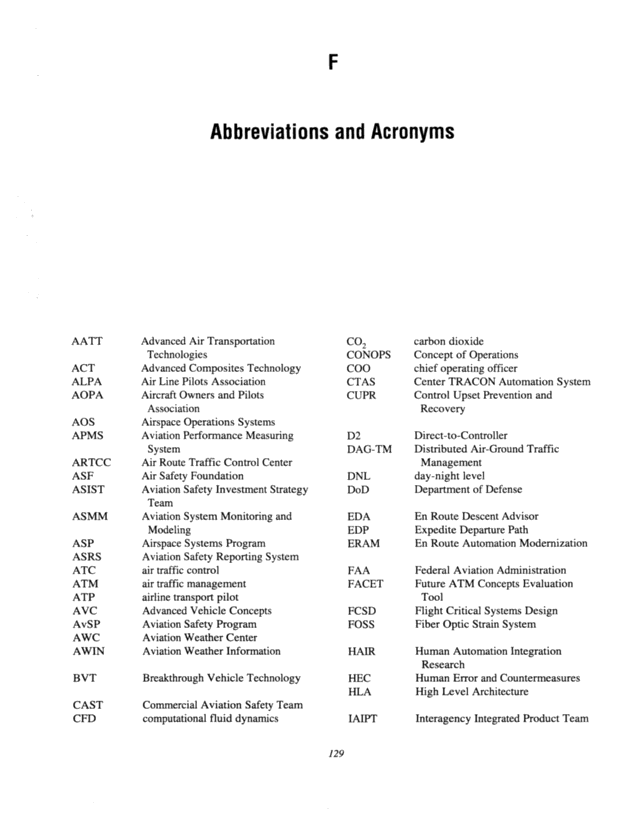Below is the uncorrected machine-read text of this chapter, intended to provide our own search engines and external engines with highly rich, chapter-representative searchable text of each book. Because it is UNCORRECTED material, please consider the following text as a useful but insufficient proxy for the authoritative book pages.
F Abbreviations and Acronyms AATT ACT ALPA AOPA AOS APMS ARTCC ASP ASIST AS MM ASP ASRS ATC ATM ATP AVC AvSP AWC AWIN BVT CAST CFD Advanced Air Transportation Technologies Advanced Composites Technology Air Line Pilots Association Aircraft Owners and Pilots . . Association Airspace Operations Systems Aviation Performance Measuring System Air Route Traffic Control Center Air Safety Foundation Aviation Safety Investment Strategy Team Aviation System Monitoring and Modeling Airspace Systems Program Aviation Safety Reporting System air traffic control air traffic management airline transport pilot Advanced Vehicle Concepts Aviation Safety Program Aviation Weather Center Aviation Weather Information Breakthrough Vehicle Technology Commercial Aviation Safety Team computational fluid dynamics 129 co2 CONOPS COO CTAS CUPR D2 DAG-TM carbon dioxide Concept of Operations chief operating officer Center TRACON Automation System Control Upset Prevention and Recovery Direct-to - Controller Distributed Air-Ground Traffic Management DNL day-night level DoD Department of Defense EDA EDP ERAM FAA FACET FCSD FOSS HAIR HEC HLA IAIPT En Route Descent Advisor Expedite Departure Path En Route Automation Modernization Federal Aviation Adm~nistration Future ATM Concepts Evaluation TooT Flight Critical Systems Design Fiber Optic Strain System Human Automation Integration Research Human Error and Countermeasures High Level Architecture Interagency Integrated Product Team
130 AN ASSESSMENT OF NASA 'S AERONA UTICS TECHNOLOGY PROGRAMS IFR instrument flight rules SATS Small Aircraft Transportation System IMC instrument meteorological conditions SBIR Small Business Innovation Research award lidar light detection end ranging SLMFST Super Lightweight Multifunctional Systems Technology McTMA Multi-Center Traffic Management SMS Surface Management System Advisor SVS Synthetic Vision Systems MEMS microelectromechanical systems SWAP System-Wide Accident Prevention NCAR ~ . . NAOMS National Aviation Operations Measurement Service NAS National Airspace System NASA National Aeronautics and Space Administration National Center for Atmospheric Research NEXRAD Next Generation Weather Radar NextNAS NASA Exploratory Technologies for the NAS TAMDAR Tropospheric Airborne Meteorological TCAT TMA TPAWS 1 - 1 - -- Data Reporting Twenty-First Century Aircraft Technology Traffic Management Advisor Turbulence Prediction and Warning Systems TRACON Terminal Radar Approach Control TRL technology readiness level NO oxides of nitrogen UEET Ultra-Efficient Engine Technology NRC National Research Council URETI University Research end engineering Technology Institute OMB Office of Management and Budget OO object-oriented VAATE Versatile Affordable Advanced Turbine Engine PDARS Performance Data Analysis and VAMS Virtual Airspace Modeling Systems Reporting System VARTM vacuum-assisted resin transfer molding pFAST Passive Final Approach Spacing Tool VAST Virtual Airspace Simulation PI principal investigator Technologies PPSF Psychological and Physiological VDLM3 VHF Data Link Mode 3 Stressors end Factors VHF very high frequency VHM vehicle health monitoring QAT Quiet Aircraft Technology VSP Vehicle Systems Program RMP Research Management plan WINCOMM Weather Information Communications RTP Research Transition Plan WxAP Weather Accident Prevention SAAP Single Aircraft Accident Prevention


